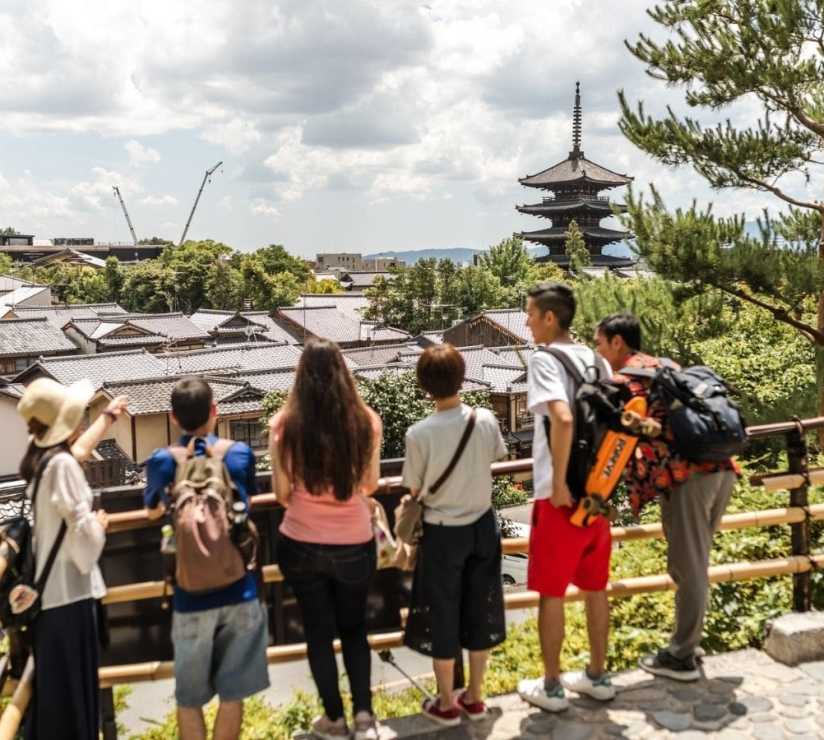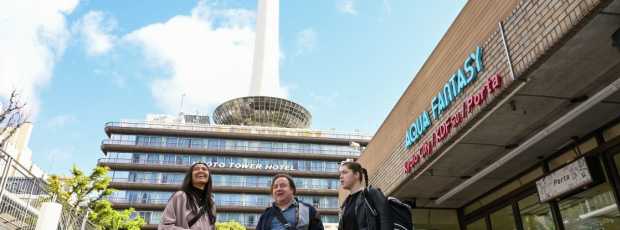Table Of Contents
- Why "Cool" in Kyoto Looks Different
- Starting Your Journey: Kyoto Station
- Northern Kyoto: Golden Perfection and Silver Contemplation
- Central Kyoto: Imperial Heart and Daily Life
- The Spiritual Heart: Temples That Define Kyoto
- Gion: Living Heritage
- Fushimi: Sake and Sacred Mountains
- Arashiyama: Bamboo Cathedral
- Cherry Blossoms: Seasonal Crown
- Autumn Colors and Night Illuminations
- Contemporary Culture: Manga and Modern Life
- Hidden Gems and Planning
- Food Culture and Authentic Experiences
- Transportation and Practical Tips
- Building Deeper Connections
- Why Kyoto Stays With You
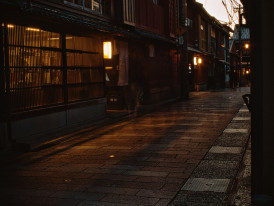
A quiet Kyoto alley with a mix of modern and traditional facades in soft morning light Photo by Tom Swinnen on Unsplash

Traditional wooden house with modern bicycle parked outside, morning shadows creating patterns Photo by tommao wang on Unsplash
Why "Cool" in Kyoto Looks Different
When my Irish father first arrived in Kyoto, he expected temples and tradition. What he found was my mother arranging flowers in a 600-year-old house while discussing manga with the neighborhood baker. That contradiction defines what makes cool things to do in Kyoto, Japan, so uniquely compelling.
I've spent three decades watching visitors rush between obvious spots, missing the quiet magic that happens in between. Real Kyoto reveals itself slowly, in morning light filtering through bamboo, in cherry blossoms catching on old wooden eaves, in conversations over green tea with strangers who become friends.
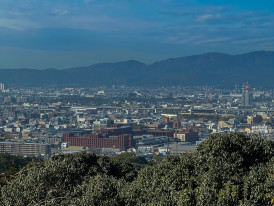
Panoramic view from Kyoto Station's observation deck showing city sprawl toward mountains Photo by Nelemson Guevarra on Unsplash
Starting Your Journey: Kyoto Station
Kyoto station greets you with architectural drama, Hiroshi Hara's glass and steel cathedral rising impossibly high. The contrast with 1,200 years of history outside never stops surprising me.
From Kyoto Station, you can reach every corner of the city. The main concourse becomes a staging ground for discovery. The tenth-floor observation deck offers views across the city's low-rise skyline to the mountains beyond.
Kyoto Station connects to Shijo Station via the Karasuma Line, dropping you into the commercial heart. The JR Nara line takes you toward Fushimi's sake breweries, while local lines fan out to every major temple and district.
Looking for a private city experience in Kyoto?
Explore the city with a local who plans a private day just for you; no groups, no scripts.
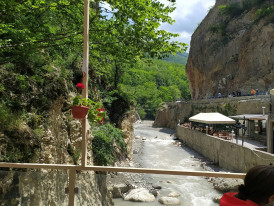
Traditional platform dining over mountain stream with diners enjoying riverside meal Photo by Parvana Mahmudlu on Unsplash
Northern Kyoto: Golden Perfection and Silver Contemplation
Northern Kyoto holds the city's most famous temple, and for good reason. Kinkaku-ji temple, the golden pavilion, sits like a meditation on perfection, three stories of gold leaf reflected in a mirror-perfect pond.
I've watched sunrise light the golden pavilion hundreds of times, and it never becomes routine. Kinkaku-ji changes with weather and season, brilliant under summer sun, ethereal in winter snow, mystical when autumn mist rises from the water.
Ginkaku ji temple, the silver pavilion, offers completely different energy. Where Kinkaku ji dazzles, Ginkaku ji contemplates. The silver pavilion never received its intended silver coating, leaving natural wood that weathers beautifully through Kyoto's seasons.
Philosopher's path connects Ginkaku-ji to the broader temple district, following a canal lined with hundreds of cherry trees. During cherry blossom season, this becomes Kyoto's most romantic walk, petals floating on dark water.
Hidden Mountain Temples
Northern Kyoto hides dozens of smaller temples. Kurama Dera temple requires a train ride into the mountains, but rewards you with hiking trails and temple buildings scattered through an ancient forest. The journey becomes part of the experience.
Kifune shrine honors the Shinto god of water, and the approach through mountain forest feels appropriately mystical. In summer, restaurants along the river offer dining on platforms built over rushing water.
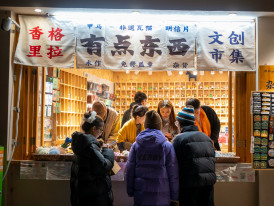
Traditional sweet shop vendor offering samples to interested customers Photo by leoon liang on Unsplash
Central Kyoto: Imperial Heart and Daily Life
Central Kyoto centers around the Kyoto Imperial Palace, which opened to public tours only recently. The imperial palace complex demonstrates Japanese architecture at its most formal, with vast wooden halls and gardens that housed emperors for over a thousand years.
The Kyoto Imperial Palace sits within Imperial Park, where locals jog and families picnic. This integration of sacred and mundane defines Kyoto's character, historic sites woven into daily routines.
Nijo Castle represents shogun authority made manifest in architecture. The castle's "nightingale floors" squeak warnings of footsteps, while painted screens depict power through tigers, eagles, and blooming cherry trees.
Nijo Castle gardens change dramatically through seasons. Spring brings cherry blossoms in over 400 varieties, while autumn transforms maples into living fire.
Nishiki Market: Kyoto's Kitchen
Nishiki Market has fed Kyoto for four centuries. The covered market stretches for five blocks, connecting central Kyoto to merchant districts that built the city's prosperity.
Walking Nishiki market provides education in Japanese food culture. Vendors offer samples of Kyoto specialties — pickled vegetables, powdered green tea, handmade sweets, and seasonal delicacies. The narrow shopping street culture extends beyond Nishiki market into broader merchant districts.
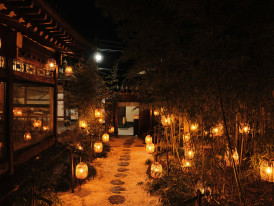
Garden illumination at night with stone lanterns and subtle lighting effects Photo by Austin Curtis on Unsplash
The Spiritual Heart: Temples That Define Kyoto
Kiyomizu dera temple demonstrates Japanese engineering at its most ambitious, a wooden stage jutting from the hillside, supported entirely without nails. The temple offers sweeping views across Kyoto.
Kiyomizu Dera Temple changes character dramatically through the seasons. Cherry blossoms frame the temple in spring, while autumn maples create a backdrop of fire-colored leaves. Evening illuminations during peak seasons transform the temple into something magical.
Many of Kyoto's temples carry Unesco world heritage site designation, recognizing their architectural and cultural significance. This protection preserves not just buildings, but entire ecosystems of traditional crafts and spiritual practices.
Kodaiji temple offers more intimate temple experiences. The temple's gardens feature perfectly composed views and host some of Kyoto's most spectacular night illuminations, using subtle lighting to transform gardens into dreamscapes.
Yasaka shrine marks the boundary between sacred and secular Kyoto. The shinto shrine sits at Gion district's entrance, where traditional teahouses coexist with modern restaurants and bars.
What if your day in Kyoto was planned by someone who knows it — and you?
City Unscripted matches you with a local host who creates a private experience based on your interests, not a set route.
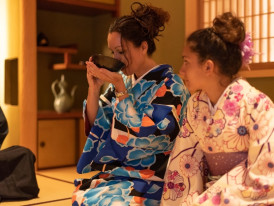
Traditional tea ceremony in progress with precise hand movements and seasonal arrangements
Gion: Living Heritage
Gion represents Kyoto's most famous historic district, where traditional teahouses maintain cultural practices largely unchanged since the Edo period. The geisha districts function as working neighborhoods, not museums.
Miss Hanami Koji, the main street through Gion, connects traditional entertainment with contemporary dining. Gion Shijo Station provides easy access, connecting traditional culture with modern transportation.
The traditional tea ceremony continues to thrive in Gion's teahouses, where guests experience this refined art form in its original setting. Japanese sweets served during a tea ceremony change with seasons, representing edible art.
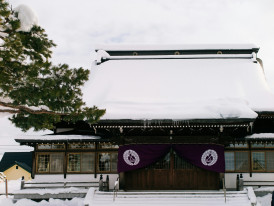
Train station with shrine entrance visible in near distance Photo by Natalie Su on Unsplash
Fushimi: Sake and Sacred Mountains
Fushimi Inari Shrine creates one of Japan's most recognizable experiences, thousands of vermilion torii gates creating tunnels up the sacred mountain. The gates represent offerings from businesses seeking divine favor.
Fushimi Inari Station sits conveniently close to the shrine entrance. The hike through Fushimi Inari can take several hours if you climb to the summit, but even short walks through gate tunnels create memorable experiences.
Fushimi district has produced sake for over 400 years. Many breweries offer tours and tastings, providing education in this crucial aspect of Japanese culture.

Scenic train approaching mountain station with bamboo forest visible on hillsides Photo by Sandra-Beatrice Molnar on Unsplash
Arashiyama: Bamboo Cathedral
Arashiyama bamboo grove creates one of nature's most immersive experiences, walking through towering bamboo that filters sunlight into green-tinted columns. The bamboo grove extends for several kilometers.
Wind through the bamboo grove creates distinctive music, rustling, creaking, and whispering that adds another dimension to the visual drama. This acoustic environment enhances the immersive experience.
Saga Arashiyama Station serves as the main access point. Jr Saga Arashiyama Station provides additional options, making Arashiyama suitable for various day trip itineraries.
Tenryu-ji demonstrates how Zen temple architecture integrates with the natural landscape. The temple's rock garden represents one of Japan's finest examples of this distinctive art form.
Tip
We match you with the right host, not just any guide.Want to experience the real Kyoto with someone who lives there?
A fully private experience, planned and led by a local host who tailors the day to you
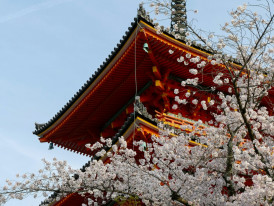
Temple pagoda framed by blooming cherry branches with soft morning light Photo by Josiah Ferraro on Unsplash
Cherry Blossoms: Seasonal Crown
Cherry blossom season transforms Kyoto into a city-wide celebration of transient beauty. Cherry blossoms represent core Japanese aesthetic principles, the beauty of impermanence and seasonal awareness.
Maruyama Park serves as Kyoto's primary hanami destination, where thousands gather under blooming cherry trees for picnics and contemplation. Cherry blossom season timing varies yearly, but typically early April brings peak blooms.
Many temples become even more magical during the cherry blossom season. Popular temples require patience with crowds, but spectacular displays justify the inconvenience.
Cherry trees line streets throughout Kyoto. The Kamo River becomes particularly spectacular, with cherry trees along both banks creating a corridor of blossoms through the urban landscape.
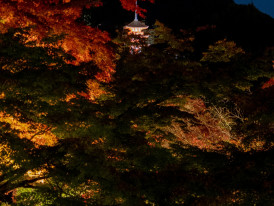
Temple grounds illuminated at night showing glowing autumn leaves against dark architecture Photo by YANGHONG YU on Unsplash
Autumn Colors and Night Illuminations
Fall colors rival cherry blossoms for seasonal drama, transforming maples into torches of red, orange, and gold. The autumn season extends longer than spring's brief period.
Many temples host special night illuminations during peak seasons, using lighting to enhance natural drama. These events create magical evening experiences.
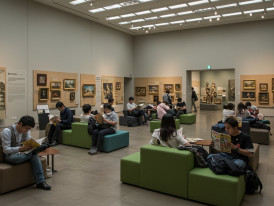
Museum visitors reading manga in comfortable indoor spaces with extensive wall collections
Contemporary Culture: Manga and Modern Life
Kyoto International Manga Museum demonstrates how traditional culture adapts to contemporary art forms. The museum houses over 300,000 manga volumes in a former elementary school.
Contemporary Kyoto successfully integrates traditional culture with modern life. Coffee shops occupy traditional buildings, and young people adapt traditional dress for modern occasions.
Downtown Kyoto around Shijo Station showcases this integration most clearly, where department stores, traditional shops, and restaurants create vibrant mixed-use districts.
Ready to plan your perfect day in Kyoto?
Start your experience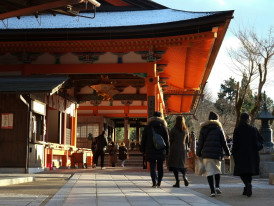
Respectful visitors observing temple etiquette while appreciating traditional architecture Photo by Adam Lamperd on Unsplash
Hidden Gems and Planning
Moss temple (Saiho-ji) requires advance reservations and demonstrates how limiting access preserves beauty. The temple's moss garden creates one of Kyoto's most magical environments.
Heian shrine offers spectacular beautiful gardens that rival more famous sites while maintaining intimate scale. The gardens showcase different seasonal interests throughout the year.
Day Trip Strategies
Kyoto's compact size makes day trip planning straightforward. Northern Kyoto makes an excellent day trip focus, combining Kinkaku-ji, Ginkaku-ji, and the philosopher's path.
Day trip approaches work well, focusing on single districts, combining nearby attractions, or following themes like temples or gardens. Transportation from Kyoto Station reaches most major attractions within 30 minutes.
Seasonal Timing
Visit Kyoto timing significantly affects your experience. Cherry blossom season provides spectacular beauty but maximum crowds, while autumn offers similar drama with fewer visitors.
Each season offers distinct advantages. Summer brings festivals and extended daylight, while winter offers the smallest crowds and beautiful gardens transformed by snow.
Cultural Respect
Successful Kyoto experiences require understanding local customs, particularly around religious sites and traditional districts. Photography restrictions and appropriate temple behavior enhance rather than complicate visits.
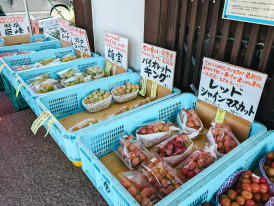
Seasonal vegetables and traditional ingredients displayed at market stalls Photo by Markus Winkler on Unsplash
Food Culture and Authentic Experiences
Authentic Kyoto food culture extends beyond guidebook restaurants. Local favorites often occupy tiny spaces and cater primarily to neighborhood residents.
Green tea culture permeates Kyoto dining, from casual cafes to formal tea ceremony settings. Traditional cuisine emphasizes seasonal ingredients and presentation that honors natural flavors.
Nishiki market provides education in seasonal eating patterns. Japanese sweets change with seasons and festivals, providing edible introductions to cultural celebrations.
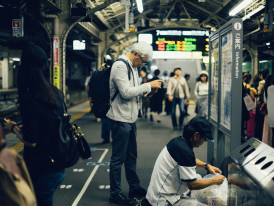
Local resident consulting transportation map at efficient train station Photo by Andrew Leu on Unsplash
Transportation and Practical Tips
The most efficient way to explore Kyoto involves understanding how different transportation modes serve different purposes. Trains work best for longer distances, while walking creates discovery opportunities.
Each major site has optimal visiting times balancing beauty, crowds, and practical considerations. Early morning visits generally offer best photography light and smallest crowds.
Worth visiting decisions depend on personal interests and seasonal timing. Some sites justify visits during any season, while others become special during specific times like cherry blossom season.
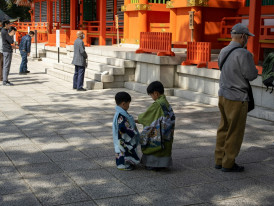
Visitor participating respectfully in local cultural activity alongside residents Photo by Kouji Tsuru on Unsplash
Building Deeper Connections
Previous trip experiences often inspire return visits focused on deeper exploration. Kyoto rewards both broad coverage and subsequent trips exploring neighborhoods or specific cultural interests.
Kyoto Japan offers enough depth to reward dozens of visits. Seasonal changes, festival cycles, and personal interest development create endless possibilities for discovery.
Real connection with Kyoto culture occurs through extended observation, respectful participation, and openness to experiences beyond predetermined expectations.
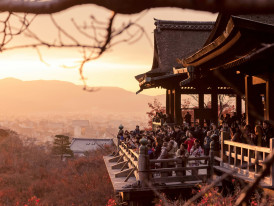
Sunset view over Kyoto showing traditional and modern elements in harmonious coexistence Photo by Match Sùmàyà on Unsplash
Why Kyoto Stays With You
Kyoto's magic lies not in any single temple or garden, but in how the city demonstrates that beauty, tradition, and contemporary life can coexist without sacrificing authenticity. The cool things to do in Kyoto, Japan, aren't just activities to check off lists, but invitations to slow down and appreciate human creativity.
Whether you spend three days or three weeks in Kyoto prefecture, the city will show you something about finding beauty in daily life, honoring tradition while embracing change. That's the real gift, not just memories of beautiful sights, but models for living with greater attention and appreciation.
Ready to plan your adventure? Explore our curated Kyoto experiences for personalized recommendations, or for travelers who prefer structured exploration with expert guidance, our curated day tours in Kyoto provide insider access to hidden temples and authentic cultural experiences that independent visitors often miss.
What if your day in Kyoto was planned by someone who knows it — and you?
City Unscripted matches you with a local host who creates a private experience based on your interests, not a set route.
Want to experience the real Kyoto with someone who lives there?
A fully private experience, planned and led by a local host who tailors the day to you
